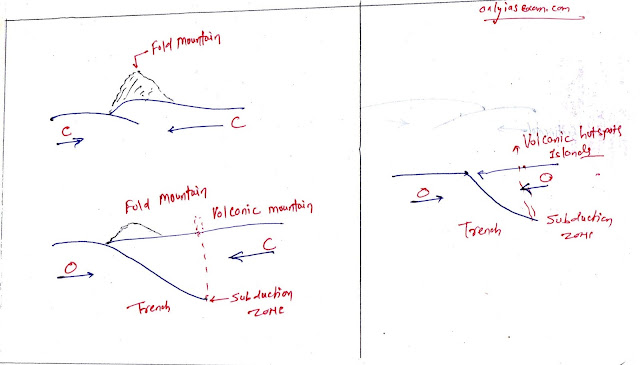Question.
Describe the concept of plate tectonics and explain the effects of the collision of two similar and two dissimilar plates. ( UPPSC 2020)
Answer.
Plate tectonics is the latest and most modern theory given by Mackenzie, Parker, and Morgan in 1967. It explains the movement of large plates as well as the development of major landforms like mountains, plains, etc.
Concept of Plate Tectonic Theory:
- Earth's lithosphere [crust + upper mantle( above the asthenosphere)) is divided into several parts. These parts are called plates, they can be large or small. There are seven major plates and more than twenty small plates on our earth. A plate can be made up of both oceans and continents. However, on the basis of the ocean and continent in a large part of the area, it can be classified into two types:
- continental plate
- oceanic plate
- Tectonic plates move over the asthenosphere. It is moving very slowly all over the earth.
- Many large and small landforms develop on the boundary of the two plates due to the horizontal and vertical movement of plates in different directions.
Effect of two similar plates and two dissimilar plates colliding with each other:
Three types of collisions are possible:
- continental continental collision
- ocean ocean collision
- continental and oceanic collisions
Effect of collision of continent and continents convergence:
- Continental plates are thicker and lighter, and due to the collision of two continental plates, one landmass moves upwards on the other, forming very large fold mountains.
- The collision of the Indian plate and the Eurasian plate is a good example of a continental-continental collision. A giant fold mountain like the Himalayas has been formed on its border.
- The origin of earthquakes at the collision boundary is periodic and the focus of the earthquake is deep.
- Volcanic activity is usually absent in the collision boundary due to the greater thickness of the two plates.
Effect of Collision of Ocean and Ocean Convergence:
- Since the oceanic plates are thin and heavy, the collision of the two plates causes the subduction of one of the lighter plates.
- Volcanic mountains are formed above the subduction zone, which appears as some islands in the ocean.
- Deep trenches are formed near the subduction zone, and the Mariana Trench is formed in the subduction zone in the Pacific Ocean.
- Strong earthquake activities occur at the collision boundary and they can be the driving force of a tsunami.
- For example, the Ring of Fire in the Pacific Ocean.
Effect of collision of continental and oceanic plates:
- As we know that continental plates are thicker than oceanic plates but lighter than oceanic plates. Due to the heavy nature of oceanic plates, it sinks and melts and forms subduction zones.
- The fold mountains are formed at the convergence zone but it is less than the fold mountains resulting from the continental-continental collision.
- Volcanic mountains are formed just above the subduction zone.
- Earthquake movements are also observed at the collision sites.
- For example, the Pacific Plate (Ocean Plate) and the North American and South American Plates (Continental Plate) collided to form the Rocky and Andes fold Mountains.
- What is plate tectonics? how do plate movements transform the earth's crust? ( 25 Marks, 66th BPSC geography Optional Paper)
- Bring about the basic difference between the drift theory and Plate tectonics. (UPPSC)
- Critically examine plate tectonics and explain its relation to the evolution of major landform features on the surface of the earth. ( BPSC, 2019)
- Describe the concept of plate tectonics and explain the effects of the collision of two similar and two dissimilar plates. ( UPPSC 2020)
- State the concept of plate tectonics. How does it help in explaining the formation of the Himalayas and the Appalachian Mountains? (UPSC 2014, 250 words, 20 marks)
You may like also:
- Describe the concept of plate tectonics and explain the effects of the collision of two similar and two dissimilar plates
- Critically examine plate tectonics and explain its relation to the evolution of major landform features on the surface of the earth.
- The Basic difference between the drift theory and Plate tectonics
- What is plate tectonics? how do plate movements transform the earth's crust?
- GEOSYNCLINES THEORY BY KOBER
- CONTINENTAL DRIFT THEORY
- ISOSTASY IN GEOGRAPHY
- SEAFLOOR SPREADING
- PLATE TECTONICS THEORY (PTT)
- RECENT VIEWS ON THE MOUNTAIN BUILDING
- प्लेट विवर्तनिकी क्या है ? प्लेट संचलन कैसे भूपटल में बदलाव लाता है ?
- महाद्वीपीय विस्थापन सिद्धांत व प्लेट विवर्तनिकी सिद्धांत में मूलभूत अंतर बताये |
- प्लेट विवर्तनिकी के सिद्धांत का वर्णन कीजिये तथा दो समान एवं दो भिन्न प्लेटो के टकराव से होने वाले प्रभाव की व्याख्या कीजिये।


ConversionConversion EmoticonEmoticon